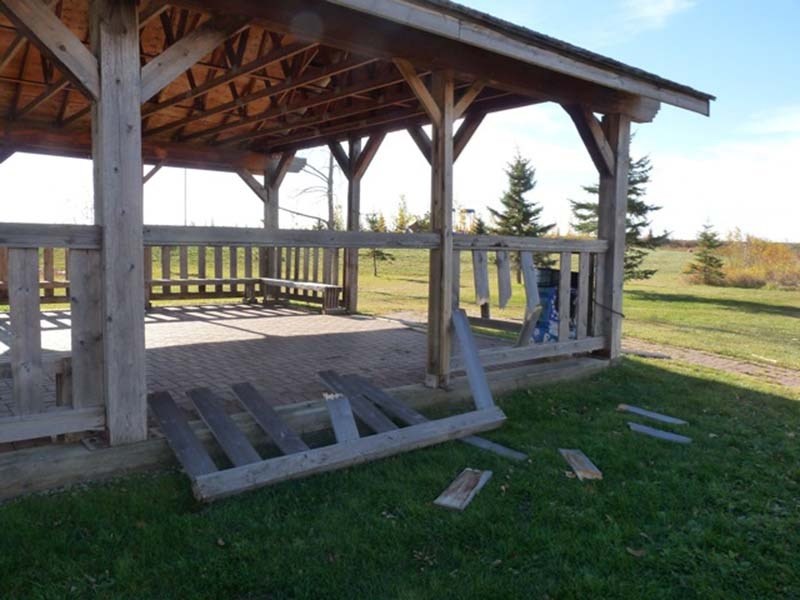St. Albert RCMP are looking for the public’s help to find out who smashed up the BLESS shelter this week.
At about 10 a.m. Tuesday, reports local environmentalist Elke Blodgett, a city resident called her to say that the Big Lake Environment Support Society (BLESS) shelter on the Red Willow Trail at the end of Rodeo Drive in the Riel Industrial park had been vandalized.
Blodgett, who passed the report along to the authorities, said the shelter had been intact when she visited it the previous evening at around sunset.
Blodgett said that most of the boards along the shelter’s south and river-facing sides had been smashed loose as of Tuesday morning, with some of the boards split in half. “This took major violence to tear this down,” she said – so much that she suspected tools were involved.
Blodgett said she was upset by this destruction, calling it the worst case of vandalism she had ever seen at the shelter. “It is so utterly pointless to destroy a little park shelter.” She also voiced concerns that new structures installed at the Lois Hole Provincial Park might also be at risk.
Built by BLESS over a decade ago, the shelter is a popular rest-spot and rally point for trail users, and is technically city property.
Public works crews fixed the shelter Tuesday afternoon, said city asset manager Chris Richards. About five of the 12 sections of railing had been damaged, with some rails broken and others pushed into the ground. He pegged the damages at about $600.
“Vandalism is a direct cost to the taxpayer and also affects the quality of life for our residents and visitors,” Richards said.
RCMP were investigating, said Cpl. Doug Enns, but there wasn’t much forensic evidence left at the scene. “A witness walking by would be very helpful.”
Anyone who sees vandalism in progress should call the RCMP at 780-458-7700. If you see something wrecked after the fact, call public works at 780-459-1557.
Has a bird hit your house? A University of Alberta researcher wants to hear from you as part of a study on bird strikes.
U of A ecology student Justine Kummer put out a call this week for volunteers in an ongoing study on bird collisions. The study is a continuation of one done last year by fellow researcher Erin Bayne that suggested about 22 million birds die each year from smacking into Canadian homes.
A recent Environment Canada study found that about nine per cent of all bird deaths in Canada were caused by collisions with buildings, making them the second greatest cause of anthropogenic bird deaths after cats (which cause a whopping 73 per cent of bird deaths).
“It’s believed that homes represent up to 90 per cent of all window collision mortality,” Kummer said. While skyscrapers usually get the blame for bird deaths, homes do the most damage since there are so many more of them.
But there have been just a handful of studies on this subject, Kummer said, none of which made observations year-round.
Kummer hoped to get a better grip on the number of birds hitting residential homes in Canada, why those hits occur, and how (if at all) these hits affect bird populations.
The Birds and Windows Project asks volunteers to survey a two-metre space around their homes for bird strikes (fatal and not) daily for about a month, Kummer said.
When they find one, they’ll be asked to file a report at the study’s website recording the time and place of the hit, as well window size and number, the amount of nearby vegetation, the presence of bird feeders, and other facts. Participants should also file reports on days without any bird strikes, she noted.
Kummer said she hoped the study would help her figure out what causes birds to hit buildings. Bird-shaped decals and curtains are thought to help prevent them, she said.
About 500 people have signed up for the study so far, Kummer said. She hoped to have the study wrapped up in about a year.
Visit birdswindows.biology.ualberta.ca for details.




